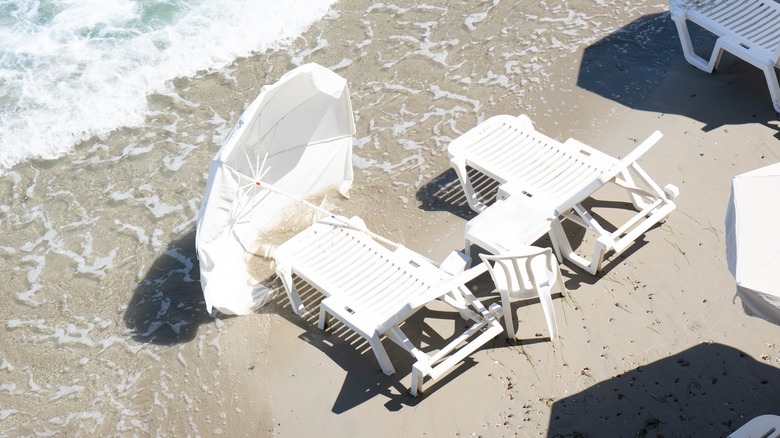The Unexpected, Popular Beach Item That Can Easily Become A Dangerous Hazard
When envisioning a beach day, images of sun-soaked sand, crashing waves, and the cheerful hum of beachgoers likely come to mind. To fully enjoy such a day, there are a few basic things one must bring to the beach: sunscreen, towels, water and snacks, a bathing suit, and an umbrella for some much-needed shade. However, among these must-haves, one unexpected, popular beach item can easily become a dangerous hazard: the umbrella. This brightly colored and often patterned canopy provides much-needed shade from the intense sun, making it a staple for beach lovers seeking respite from UV rays. But many don't realize that this beloved item can swiftly transform from a source of comfort into a source of injury (or worse).
According to the Consumer Products Safety Commission (CPSC), nearly 3,000 people across America are hospitalized every year due to beach umbrella-related injuries (per People). To put that staggering statistic in perspective, in 2023, the International Shark Attack File (ISAF) accounted for only 36 unprovoked shark attacks in the U.S. — yet getting bit by a shark while swimming seems to be the first thing on every beachgoer's mind, certainly not being impaled by an umbrella. In June 2024, a dislodged umbrella got stuck in a woman's leg while she was sunbathing at the beach. Another particularly devastating accident occurred in 2022 (via People) when a 63-year-old woman in South Carolina died an hour after getting impaled in the chest by a loose umbrella. This is why the CPSC has a safety alert: "Beware! Airborne Beach Umbrellas Can Kill."
The appeal and hidden dangers of beach umbrellas
Despite the fact that flying umbrella injuries are more common than shark attacks, lightning strikes, and even airplane crash fatalities combined, umbrellas are an essential part of the beach-going experience for many. They offer shade and can protect against harmful UV radiation by up to 70%, with some specialized, high-quality sun umbrellas reaching up to 99% protection. With the increasing awareness of skin cancer and sunburns, the use of beach umbrellas has surged in popularity. Families with children, elderly individuals, and those with sensitive skin particularly benefit from the shade and protection these umbrellas provide.
So, how does something so helpful become so hazardous? The most significant danger arises from wind. Coastal areas are known for their unpredictable and often strong gusts of wind, which can easily uproot improperly secured umbrellas — turning them into rogue spears or flying kites, quite literally weapons. A beach umbrella caught by the wind can turn into a projectile, posing severe risks to beachgoers across the entire beach, with injuries ranging from minor cuts and bruises to severe head trauma and even fatalities. The metal or wooden poles of umbrellas can cause horrific harm upon impact, and their unpredictable flight path makes them particularly dangerous. Improperly fastened umbrellas can also get washed out to the sea or turn into environmental debris after a particularly bad wind storm.
Safety measures and best practices
To mitigate the risks associated with beach umbrellas, it's crucial to follow proper setup and safety procedures. The first and most important step is to anchor the umbrella securely. Ensure the umbrella is buried at least 2 feet deep in the sand — which might take a bit of wiggling back and forth, but it is absolutely essential. This might involve using a screw base or a specialized sand anchor to provide a firm hold, depending on the structure of your umbrella. According to an ASTM report, a beach umbrella with a 7.5-foot diameter must be secured with at least 75 pounds of resistance to not blow away in winds reaching 30 miles per hour. Simply pushing the pole into the sand will not work.
Feel where the wind is coming from and tilt the umbrella into the wind to prevent it from catching the underside of the umbrella and lifting it out of the sand. Always check the weather forecast and pay special attention to wind speeds. Beware of hurricane season! Better yet, on especially windy days, it's probably best to forgo using an umbrella altogether or opt for an alternative shade solution, such as a pop-up beach tent, cabana, or sun shelter. Otherwise, look for umbrellas that come with built-in safety features, such as advanced anchoring systems or wind vents, which allow wind to pass through without lifting the umbrella. With proper precautions, that 3,000 annual umbrella injury statistic can go down to zero.


